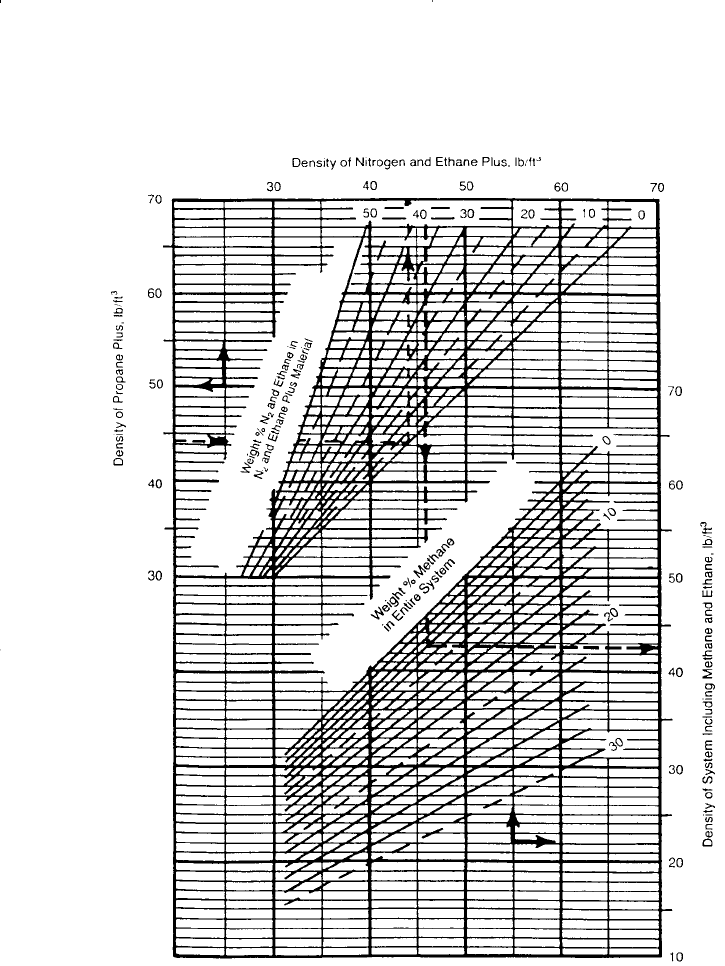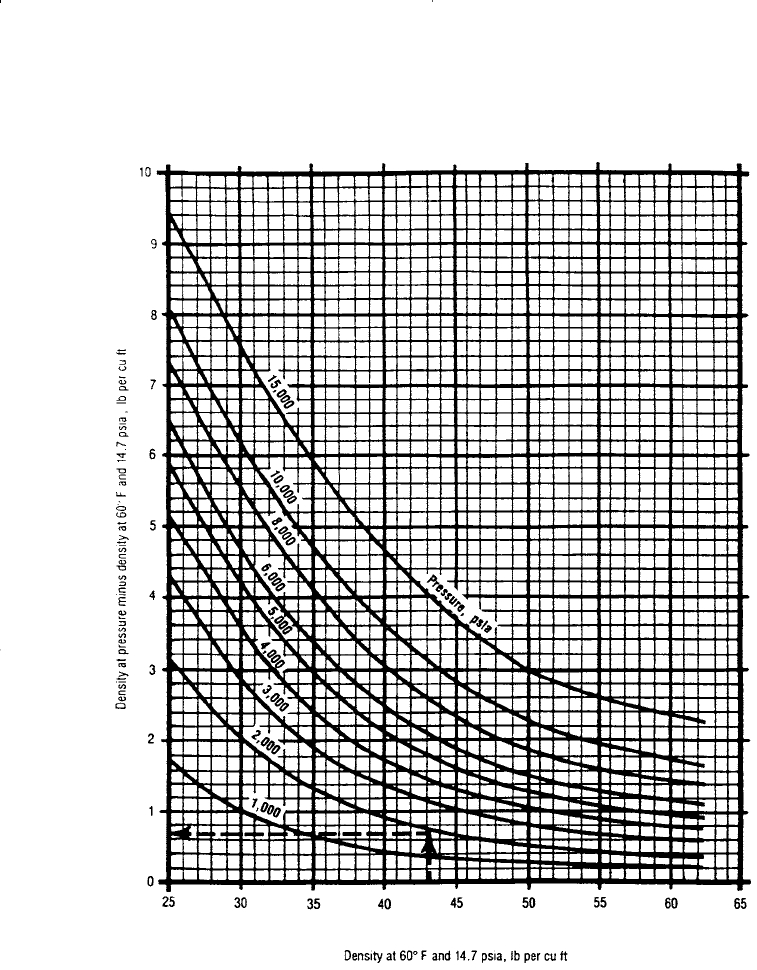Tarek Ahmed. Reservoir engineering handbook
Подождите немного. Документ загружается.


Component z
i
K
i
x
i
y
i
CO
2
0.0005 81.14 0000 0.0014
N
2
0.0008 1,159 0000 0.026
C
1
0.0784 229 0.0011 0.2455
C
2
0.0648 27.47 0.0069 0.1898
C
3
0.1282 6.411 0.0473 0.3030
i – C
4
0.0555 2.518 0.0375 0.0945
n – C
4
0.0564 1.805 0.0450 0.0812
i – C
5
0.0263 0.7504 0.0286 0.0214
n – C
5
0.0264 0.573 0.02306 0.0175
C
6
0.0566 0.2238 0.0750 0.0168
C
7+
0.5061 0.03613 0.7281 0.0263
With n
L
= 0.6837 and n
v
= 0.3163.
Step 6. Calculate the actual number of moles of the liquid phase at the
stock-tank conditions from Equation 15-39:
Step 7. Calculate the total number of moles of the liberated gas from the
entire surface separation system:
Step 8. Calculate apparent molecular weight of the stock-tank oil from
its composition to give (M
a
)
st
= 200.6.
Step 9. Calculate the density of the stock-tank oil by using the Standing
correlation to give:
Step 10. Calculate the API gravity of the stock-tank oil:
Step 11. Calculate the gas solubility from Equation 15-42 to give:
API =
(
)
−=141 5 0 816 131 5 41 9./. . .
γ= =50 920 62 4 0 816 60 60...
oo
ρ
o
st
(
)
= 50 920.
nn
vL
st
=−
(
)
=− =1 1 0 48554 0 51446..
n
L
st
(
)
=
(
)
(
)
(
)
(
)
=1 0 7209 0 9851 0 6837 0 48554... .
1068 Reservoir Engineering Handbook
Reservoir Eng Hndbk Ch 15 2001-10-25 17:41 Page 1068

Step 12. Calculate B
o
from Equation 15-43 to give:
To optimize the operating pressure of the separator, the above steps
should be repeated several times under different assumed pressures and
the results, in terms of API, B
o
, and R
s
, should be expressed graphically
and used to determine the optimum pressure.
Note that at low pressures, e.g., p < 1000, equilibrium ratios are near-
ly independent of the overall composition z
i
or the convergence pressure
and can be considered only a function pressure and temperature. Under
this condition, i.e, p < 1000, the equilibrium ratio for any component i
can be expressed as:
The temperature-dependent coefficient A
i
is a characterization parameter
of component i that accounts for the physical properties of the component.
The above expression suggests that the K
i
varies linearly at a constant tem-
perature with 1/p. For example, suppose that a hydrocarbon mixture exists
at 300 psi and 100°F. Assume that the mixture contains methane and we
want to estimate the equilibrium ratio of methane (or any other compo-
nents) when the mixture is flashed at 100 psi and at the same temperature of
100°F. The recommended procedure is summarized in the following steps:
Step 1. Because at low pressure the equilibrium ratio is considered inde-
pendent of the overall composition of the mixture, use the equi-
librium ratio charts of Appendix A to determine the K
i
value of
methane at 300 psi and 100°F:
Step 2. Calculate the characterization parameter A
i
of methane from the
above proposed relationship:
A
i
=
(
)
(
)
=10 5 300 3 150.,
10 5
500
. =
A
i
K
C
1
10 5= .
K
A
p
i
i
=
B
o
=
(
)
(
)
(
)
(
)
(
)
=
113 5102 50 92
44 794 0 48554 200 6
1 325
..
.. .
. bbl STB/
R
s
=
(
)
(
)
(
)
=
2130 331 0 51446 50 92
0 48554 200 6
573 0
.. .
..
. scf STB/
Vapor–Liquid Phase Equilibria 1069
Reservoir Eng Hndbk Ch 15 2001-10-25 17:41 Page 1069

Step 3. Calculate the K
i
of methane at 100 psi and 100°F from:
In many low-pressure applications of flash calculations at constant temper-
ature, it might be possible to characterize the entire hydrocarbon mixture as
a binary system, i.e., two-component system. Because methane exhibits a
linear relationship with pressure of a wide range of pressure values, one of
the components that forms the binary system should be methane. The main
advantage of such a binary system is the simplicity of performing flash cal-
culations because it does not require an iterative technique.
Reconsider Example 15-6 where flash calculations were performed on
the entire system at 400 psia and 72
o
F. To perform flash calculations on
the feed for the second separator at 350 psi and 72
o
F, follow these steps:
Step 1. Select methane as one of the binary systems with the other com-
ponent defined as ethane-plus, i.e., C
2+
, which lumps the remain-
ing components. Results of Example 15-6 show:
• = 8.85
• = 0.7877
• = 0.089
• = 1.0 – 0.7877 = 0.2123
• = 1.0 – 0.089 = 0.911
Step 2. From the definition of the equilibrium ratio, calculate the K value
of C
2+
:
Step 3. Calculate the characterization parameter A
i
for methane and C
2+
:
The equilibrium ratio for each of the two components (at a con-
stant temperature) can then be described by:
K
p
C
1
3 540
=
,
AKp
CC
22
0 233 400 93 2
++
==
(
)
(
)
=..
AKp
CC
11
8 85 400 3 540==
(
)
(
)
=.,
K
y
x
C
C
C
2
2
2
0 2123
0 9110
0 2330
+
+
+
== =
.
.
.
x
C
2+
y
C
2+
x
C
2
y
C
1
K
C
1
K
C
1
3 150
100
31 5==
,
.
1070 Reservoir Engineering Handbook
Reservoir Eng Hndbk Ch 15 2001-10-25 17:41 Page 1070

Step 4. Calculate the K
i
value for each component at the second separator
pressure of 350 psi:
Step 5. Using the flash calculations procedure as outlined previously for
a binary system, calculate the composition and number of moles
of the gas and liquid phase at 350 psi:
• Solve for x
C1
and x
C2+
:
• Solve for and :
• Solve for number of moles of the vapor and liquid phase:
The above calculations are considered meaningless without converting
moles of liquid n
l
into volume, which requires the calculation of the liq-
uid density at separator pressure and temperature. Notice:
V
nM
La
o
=
ρ
nn
Lv
=− = − =1 1 0 0 212 0 788.. .
n
zx
xK
v
=
−
−
(
)
=
−
−
(
)
=
11
11
1
0 089 0 0746
0 0746 10 11 1
0 212
..
..
.
yy
CC
21
1 1 0 0 754 0 246
+
=− = − =.. .
yxK
CC
11
1
0 0746 10 11 0 754==
(
)
(
)
=...
y
C
2+
y
C
1
x
K
KK
xx
C
CC
1
21
1 1 0 0 266
10 11 0 266
0 0746
1 1 0 0 0746 0 9254
2
12
=
−
−
=
−
−
=
=− = − =
+
..
..
.
.. .
K
C
2
93 2
350
0 266
+
==
.
.
K
C
1
3 540
350
10 11==
,
.
K
p
C
2
93 2
+
=
.
Vapor–Liquid Phase Equilibria 1071
Reservoir Eng Hndbk Ch 15 2001-10-25 17:41 Page 1071

where M
a
is the apparent molecular weight of the separated liquid and is
given by (for a binary system):
Density Calculations
The calculation of crude oil density from its composition is an important
and integral part of performing flash calculations. The best known and
most widely used calculation methods are those of Standing-Katz (1942)
and Alani-Kennedy (1960). These two methods are presented below:
The Standing-Katz Method
Standing and Katz (1942) proposed a graphical correlation for deter-
mining the density of hydrocarbon liquid mixtures. The authors developed
the correlation from evaluating experimental, compositional, and density
data on 15 crude oil samples containing up to 60 mol% methane. The pro-
posed method yielded an average error of 1.2% and maximum error of 4%
for the data on these crude oils. The original correlation did not have a
procedure for handling significant amounts of nonhydrocarbons.
The authors expressed the density of hydrocarbon liquid mixtures as a
function of pressure and temperature by the following relationship:
where
o
= crude oil density at p and T, lb/ft
3
sc
= crude oil density (with all the dissolved solution gas) at
standard conditions, i.e., 14.7 psia and 60°F, lb/ft
3
p
= density correction for compressibility of oils, lb/ft
3
T
= density correction for thermal expansion of oils, lb/ft
3
Standing and Katz correlated graphically the liquid density at standard
conditions with:
• The density of the propane-plus fraction
• The weight percent of methane in the entire system (m )
• The weight percent of ethane in the ethane-plus (m )
C
2+
C
2
C
1+
C
1
C
3+
ρρ ρ ρ
osc p T
=+ −∆∆
MxM xM
aCC CC
=+
++11 2 2
1072 Reservoir Engineering Handbook
Reservoir Eng Hndbk Ch 15 2001-10-25 17:41 Page 1072

This graphical correlation is shown in Figure 15-9. The following are the
specific steps in the Standing and Katz procedure of calculating the liq-
uid density at a specified pressure and temperature.
Step 1. Calculate the total weight and the weight of each component in 1
lb-mol of the hydrocarbon mixture by applying the following
relationships:
where m
i
= weight of component i in the mixture, lb/lb-mol
x
i
= mole fraction of component i in the mixture
M
i
= molecular weight of component i
m
t
= total weight of 1 lb-mol of the mixture, lb/lb-mol
Step 2. Calculate the weight percent of methane in the entire system and
the weight percent of ethane in the ethane-plus from the follow-
ing expressions:
and
where (m ) = weight percent of methane in the entire system
m = weight of methane in 1 lb-mol of the
mixture, i.e., x M
(m ) = weight percent of ethane in ethane-plus
m = weight of ethane in 1 lb-mol of the mixture,
i.e., x M
M = molecular weight of methane
M = molecular weight of ethane
Step 3. Calculate the density of the propane-plus fraction at standard
conditions by using the following equations:
C
2
C
1
C
2
C
2
C
2
C
2+
C
2
C
1
C
1
C
1
C
1+
C
1
m
m
m
m
mm
C
C
c
C
C
tC
2
2
2
2
2
1
100 100
(
)
=
=
−
+
+
m
xM
xM
m
m
C
C
CC
ii
i
n
C
t
1
1
11
1
1
100 100
(
)
=
=
+
=
∑
mxM
tii
=Σ
mxM
iii
=
Vapor–Liquid Phase Equilibria 1073
Reservoir Eng Hndbk Ch 15 2001-10-25 17:41 Page 1073

with
where = density of the propane and heavier components, lb/ft
3
m = weight of the propane and heavier fractions, lb/lb-mol
V = volume of the propane-plus fraction, ft
3
/lb-mol
V
i
= volume of component i in 1 lb-mol of the mixture
m
i
= weight of component i, i.e., x
i
M
i
, lb/lb-mole
oi
= density of component i at standard conditions, lb/ft
3
Density values for pure components are tabulated in Table 1-2 in
Chapter 1, but the density of the plus fraction must be measured.
Step 4. Using Figure 15-9, enter the value into the left ordinate of the
chart and move horizontally to the line representing (m ) ; then
drop vertically to the line representing (m ) . The density of the
oil at standard condition is read on the right side of the chart.
Standing (1977) expressed the graphical correlation in the follow-
ing mathematical form:
with
where = density of ethane-plus fraction.
C
2+
ρρ
CC c
C
C
C
C
C
c
C
mm
mm
23 2
2
2
2
2
2
2
2
1 0 01386 0 000082
0 379 0 0042
2
2
++
++
++
=−
(
)
−
(
)
+
(
)
+
(
)
..
..
ρρ
sc C c
C
C
C
C
C
c
C
mm
mm
=−
(
)
−
(
)
+
(
)
+
(
)
+
++
++
21
1
1
1
1
1
1
2
1 0 012 0 000158
0 0133 0 00058
2
2
..
..
C
1+
C
1
C
2+
C
2
C
3+
C
3+
C
3+
C
3+
mxM
VV
m
cii
iC
Ci
iC
i
oi
iC
3
3
3
33
+
+
=
==
=
==
∑
∑∑
ρ
ρ
ρ
C
C
C
ii
iC
n
ii
oi
iC
n
m
V
xM
xM
3
3
3
3
3
+
+
==
=
=
∑
∑
1074 Reservoir Engineering Handbook
Reservoir Eng Hndbk Ch 15 2001-10-25 17:41 Page 1074

Figure 15-9. Standing and Katz density correlation. (Courtesy of the Gas Proces-
sors Suppliers Association, Engineering Data Book, 10th ed., 1987.)
Step 5. Correct the density at standard conditions to the actual pressure
by reading the additive pressure correction factor,
p
, from Fig-
ure 15-10, or using the following expression:
∆ρ
ρρ
p
sc sc
pp=+ − +
(
)
[]
(
)
(
)
[]
−
−
−
0 000167 0 016181 10 10 0 299 263 10
0 0425
8
0 0603
2
.. .
..
Vapor–Liquid Phase Equilibria 1075
Reservoir Eng Hndbk Ch 15 2001-10-25 17:41 Page 1075

Figure 15-10. Density correction for compressibility of crude oils. (Courtesy of the
Gas Processors Suppliers Association, Engineering Data Book, 10th ed., 1987.)
Step 6. Correct the density at 60°F and pressure to the actual temperature
by reading the thermal expansion correction term,
T
, from Fig-
ure 15-11, or from:
1076 Reservoir Engineering Handbook
Reservoir Eng Hndbk Ch 15 2001-10-25 17:41 Page 1076

Figure 15-11. Density correction for isothermal expansion of crude oils. (Courtesy
of the Gas Processors Suppliers Association, Engineering Data Book, 10th ed., 1987.)
where T is the system temperature in °R.
∆∆
∆
ρρρ
ρρ
Tscp
T
T
sc p
=−
(
)
++
(
)
[]
−
−
(
)
(
)
−
(
)
−
−
−+
()
520 0 0133 152 4
520 8 1 10 0 0622 10
245
2
6
0 0764
..
..
.
.
Vapor–Liquid Phase Equilibria 1077
Reservoir Eng Hndbk Ch 15 2001-10-25 17:41 Page 1077
